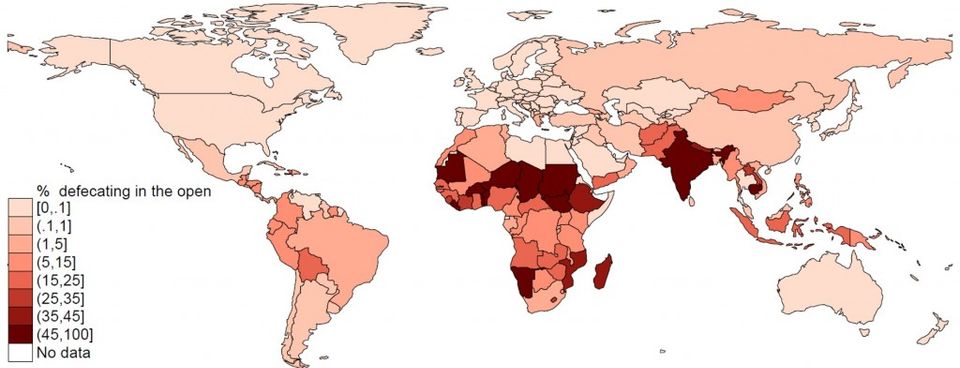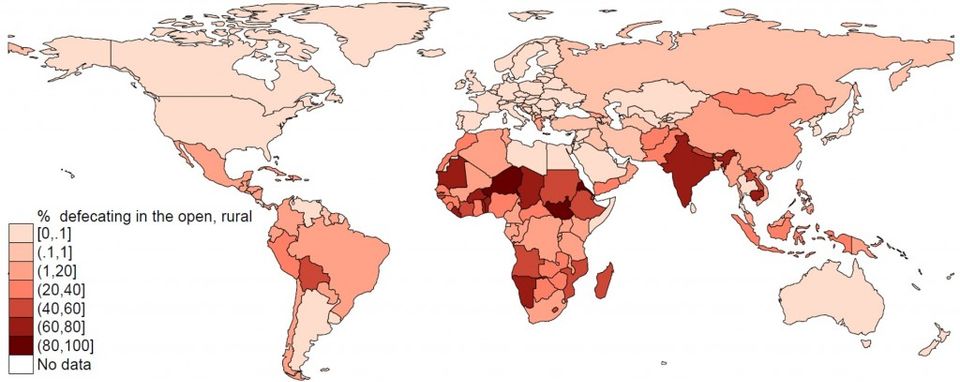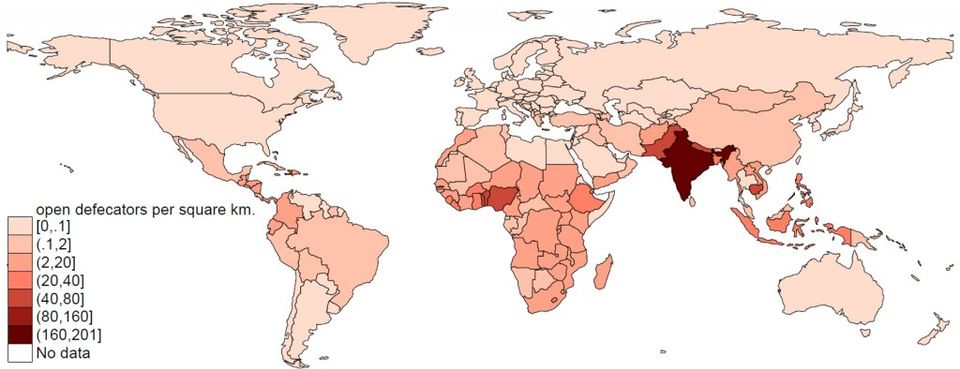New Maps: Which country has the most open defecation in the world?
— Blog Post — 3 min read
Using the method described by Friedrich Huebler on his blog, and using estimates of the WHO / UNICEF Joint Monitoring Programme on Water Supply and Sanitation, and with advice from my friend Srini, I created an open defecation map of the world.
[caption id="attachment_1579" align="aligncenter" width="630"]
 Map 1: Open Defecation in the World, 2012[/caption]
Map 1: Open Defecation in the World, 2012[/caption]
The good news, as many of you are probably aware, is that open defecation is on its way out in most of the world. About 14% of the world defecates in the open. This statistic masks vast differences between countries, however: almost no one defecates in the open in China, while in neighboring India, about 48% of the total population defecates in the open.
Indeed, open defecation is increasingly concentrated in India, and some very poor conflict-torn countries, such as South Sudan and Chad. Most very poor countries, such as Bangladesh, Afghanistan, and Congo, have reduced open defecation, and moved up the "sanitation ladder" - a term used by sanitation professionals to describe the various rungs of a ladder, from the most unhygienic open defecation to the most hygienic "improved sanitation". Most of the people in these poor countries still don't have "improved sanitation," but they have moved up the "sanitation ladder" and are well on their way to eliminate open defecation.
India stands out in this comparison. It is not as poor as sub-Saharan countries, but is worse than most of them. Only a handful of countries in the world have worse open defecation than India. Part of the reason is that whereas people in the rest of the world are happy to move to kachha unimproved or shared latrines, the "sanitation ladder" in India is mostly absent. You can read more about this in SQUAT working paper no. 1's section 3.1.2 and Table 1:
The data for India show a "missing middle": no country listed has a smaller ―middle fraction of unimproved or shared sanitation. Many countries, in contrast, have both a lower fraction of the population defecating in the open and a lower fraction with improved sanitation. In India, only 16% of the population is on a middle rung, compared with 40% in Bangladesh, and 45% for sub-Saharan Africa overall. Although the table only presents country-level statistics, the contrast for rural India is even starker: only 6% of rural Indians are in a middle category. In many countries, proceeding up the sanitation ladder was not only the path out of open defecation, but also an important step towards improved health and human capital.
Many people in rural India can afford to build simple latrines that people in poor countries such as Bangladesh use. It is also important to note that while present in Urban India, open defecation is primarily a rural issue: 89% of all the people who defecate in the open In India live in rural areas.
[caption id="attachment_1581" align="aligncenter" width="630"]
 Map 2: Open Defecation in the World, Rural, 2012[/caption]
Map 2: Open Defecation in the World, Rural, 2012[/caption]
Map 2 shows the proportion of the rural population that defecates in the open. You would see that all of South Asia, which is much poorer than India, and indeed, most of sub-Saharan Africa, has less rural open defecation than India. The countries which do have higher rural open defecation are horrible places to be in - Eritrea, South Sudan, or Chad. No one would recognise it as an achievement that India is better than these places in rural open defecation.
But is India really better than these countries when it comes to open defecation? Rice's research shows that "Open defecation is particularly harmful to children’s health where population density is high". Indeed, even intuitive reasoning would lead to the conclusion that for a kid, what matters is not the proportion of people defecating in the open in a country, but the number of people defecating in the open around his or her surroundings. A way to measure that is to measure number of people defecating in the open per square kilometre. Map 3, does exactly that.
[caption id="attachment_1582" align="aligncenter" width="630"]
 Number of people defecating in the open, per square km, 2012[/caption]
Number of people defecating in the open, per square km, 2012[/caption]
India has more than 200 people per square kilometer defecating in the open. No other country in the world has a higher number of people defecating in the open per square kilometer. In fact, India has the most open defecation per square kilometer by a long long margin: the countries which have the second and the third most number of people defecating are Haiti and Nepal, which have 79 and 77 people defecating in the open per square kilometer. Bangladesh, Pakistan, all of sub-Saharan Africa, every place on the planet, is much better than India.
Neither population nor poverty can be blamed for the situation that India is in. Bangladesh, which has a much higher population density than India and is way poorer, or China, which has a larger population, are much, much better than India when it comes to sanitation.